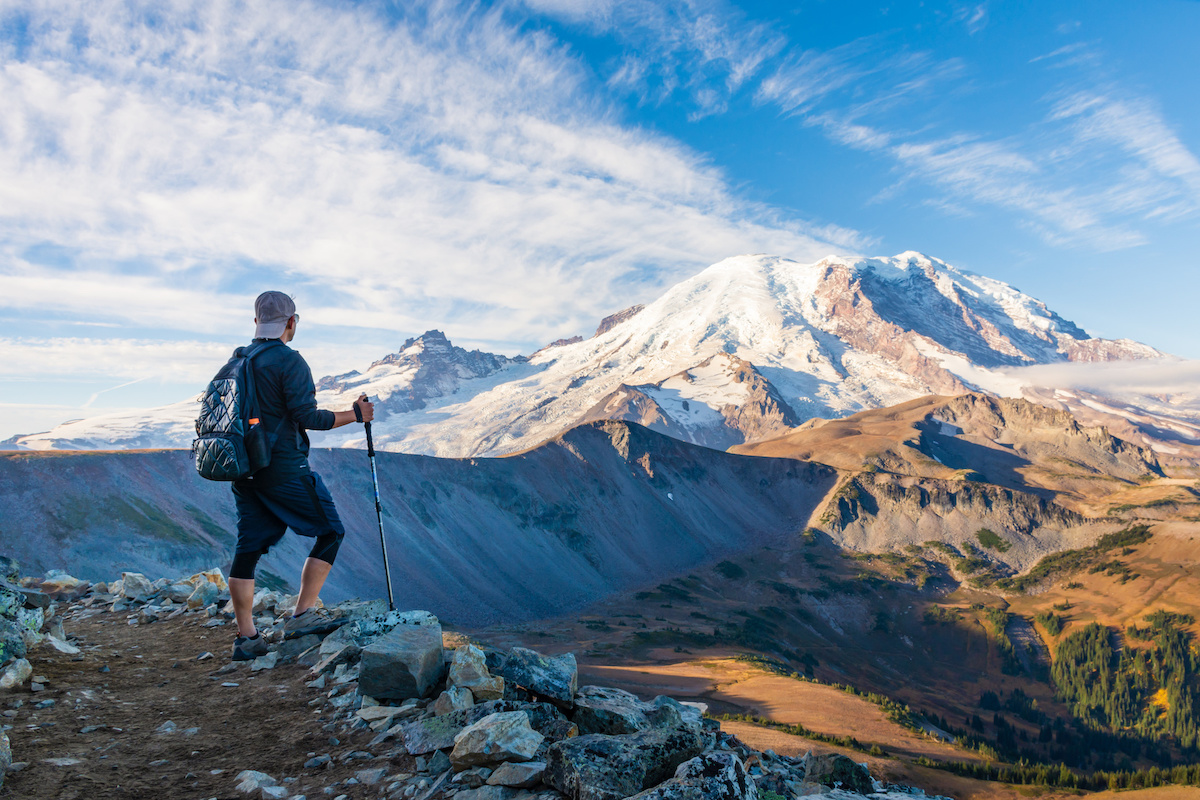Where I live in Washington state, in the Pacific Northwest of the U.S., there are—officially—nearly 700 miles of hiking trails through the old-growth forests, across the snow-capped mountain peaks, and beside the freshwater lakes of the region’s state and national parks.
I have hiked exactly zero miles of these trails. (I’m more of a beachcombing, waves-crashing, whale-watching kind of girl.)
But you can’t live in these parts without acquiring some know-how about the makings of a good hike. Every trail worth taking contains a mixture of five key elements:
- Views: A great hiking trail delivers on stunning scenery, and not just at the top, but along the way.
- Peace and quiet: Trekking through nature gets us out of our mundane routines and opens our eyes to see the world anew.
- A little challenge: While this varies greatly depending on the hiker, the need to put in a little effort makes any trail even more rewarding.
- Varied terrain: We said a little challenge, after all. Great hikes are punctuated by flat sections, small descents, and spaces that invite hikers to pause, catch their breath, and enjoy the view.
- Wildlife: Whether eagles in the trees, elk in the mountains, or simply fellow hikers you meet along the way, viewing and interacting with others (from a safe distance, of course) greatly enriches every hiker’s experience.
The same principles are important when setting the course in January for a good year. Allow me to explain.
Many begin January by focusing on grand, sweeping resolutions, seeing the month as the starting block for setting right all their bad habits (or lapsed good ones). There’s space for that. After all, there’s a lot of good that can come from setting goals. But as with any goal, just as with any hike, the key is sticking to it.
Maybe our best approach to the year is the same one we use when we lace up our hiking boots: come as prepared as possible, find reasons to keep going when you want to give up, and remember to stop often to take it all in.
January as Base Camp
Nothing beats the optimism of base camp. Your gear is clean and organized; everyone’s well-rested; your water bottle and snack reserves are full; your socks are fresh; and your feet are blister free. Trail maps are crisply folded and at the ready, and you’re looking forward to the adventure ahead. It’s easy to embrace the momentum of the moment.
In the same way, January offers us a fresh, new start. Gyms advertise membership deals. Art classes can be had at a discount. The whole year lies before us, 12 months of endless opportunity. The desire to move forward, whether by learning a new skill, tackling a challenging situation, or adopting a positive behavior, is infectious. Everyone you know is making resolutions. And underscoring it all, is our shared desire that we can be a little better, try a little harder, do a little more.
After all, at the heart of any resolution—New Year’s or otherwise—is hope.
Make Hope a Habit
Unfortunately, the newness and enthusiasm you feel at both the trailhead and in this first month of the year eventually wear off.
Inevitably, you reach a point where the temptation to turn around and go home is just as strong as the desire to keep moving forward. You’ve had some fun, made some progress up the mountain, maybe even reached a vista or two. Your body is aching in that self-satisfied, “I’m feeling muscles I didn’t even know I had / I could totally be a professional athlete” kind of way. But the path ahead looks steeper, rockier, and sure feels harder than anything you’ve faced so far. You think: I’ve come a long way. Do I really need to go any further?
This is the moment it becomes impossible to ignore one universal truth: Finding hope is easy; staying hopeful is the hard part.
In times of difficulty, hardship, or overwhelm, that optimism you felt at the beginning of the journey can evaporate, only to be replaced by discouragement, resignation, and exhaustion. How can you ensure that these moments don’t overpower you and take you off track? Make hope a habit.
- Hope is easier to build when your goal is clear. Why are you hiking this trail to begin with? Get clear on your “why.”
- Hope is easier to find when you remember past achievements. Look at all you have accomplished so far! Take heart.
- Hope is easier to trust when you reach for it consistently. Like riding a bike or popping the clutch when your ancient car won’t start, actions stay with us when we repeat them over and over again. You can do this; you already know how.
One Road, Many Destinations
With your eyes on the prize and hope enough to see you through to the end of the hike, success (and the summit) seem a fitting reward—but they’re not the only reward. The best hikes feature the best views. Views, plural.
Stop. Look around. Feel the sun warm your face and the breeze cool your skin. Take a selfie next to that little waterfall. Smile at the people you pass. Smell the very real flowers in your path. And all the metaphorical ones, too. The saying goes, “It’s not the destination; it’s the journey.” I’ll do you one better: It’s not the destination or the journey. It’s both. It’s all the ways your eyes get wider, your lungs fill more deeply, and your curiosity is piqued. It’s making the most of every advertised scenic viewpoint and a hundred unexpected ones. It’s celebrating each checkpoint on the way to the top of the mountain, and then celebrating again on the way back down.
Lace Up Your Boots
On the feeling of starting something new, Steve Jobs once said, “The heaviness of being successful was replaced by the lightness of being a beginner again, less sure about everything.” A new year and, in truth, the start of any new venture, gives us that opportunity to once again be a wide-eyed optimist, digging out our maps, lacing up our boots, and hitting the trail.
Grab your backpack, and let’s go!





